Food Security: Understanding the Importance of Adequate and Safe Food
VerifiedAdded on 2023/05/30
|9
|3274
|473
AI Summary
This article discusses the importance of food security and its impact on society. It explains the factors that contribute to food security and how it affects different social classes. The author shares their personal experience and how culture and society play a role in food security.
Contribute Materials
Your contribution can guide someone’s learning journey. Share your
documents today.
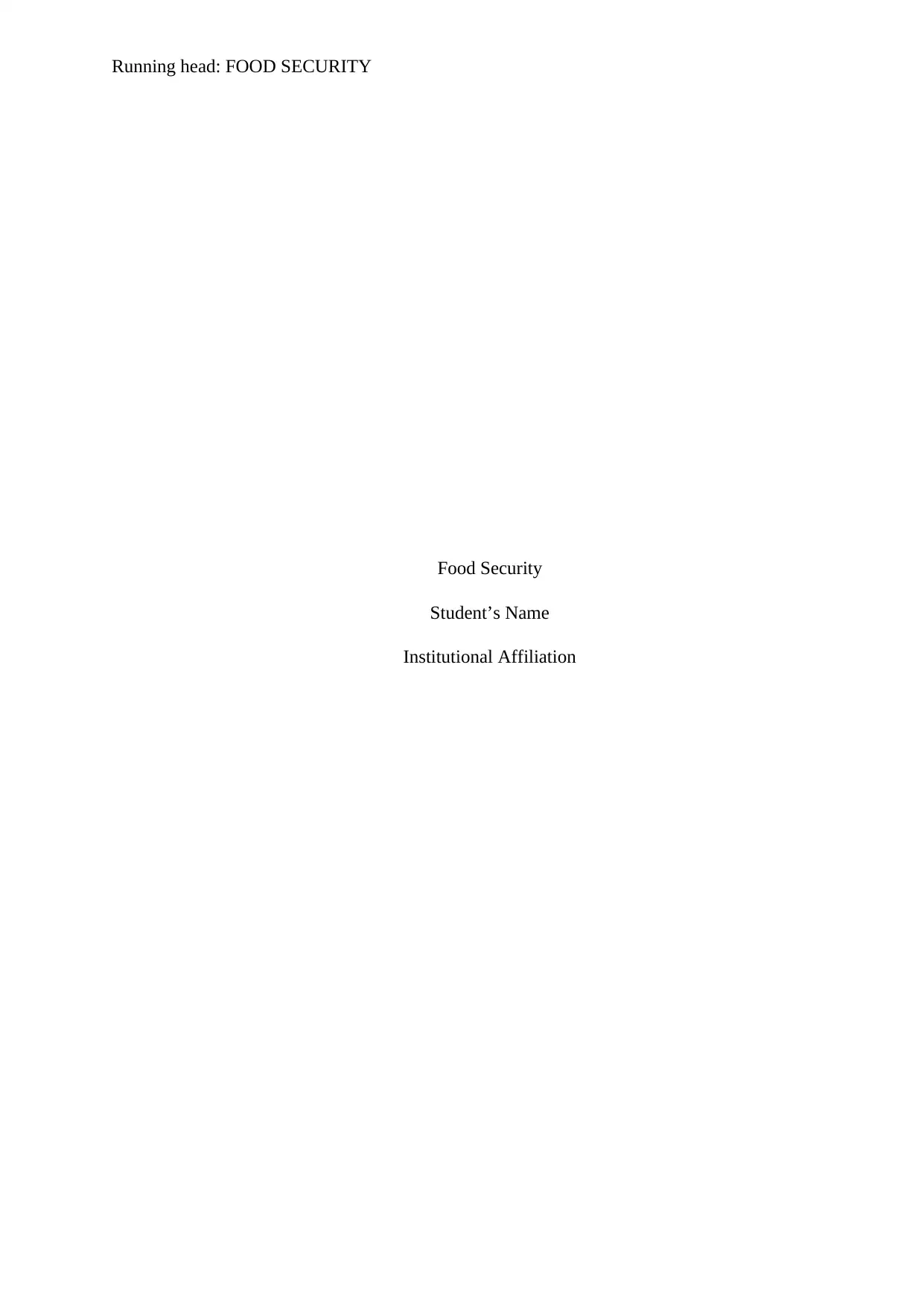
Running head: FOOD SECURITY
Food Security
Student’s Name
Institutional Affiliation
Food Security
Student’s Name
Institutional Affiliation
Secure Best Marks with AI Grader
Need help grading? Try our AI Grader for instant feedback on your assignments.
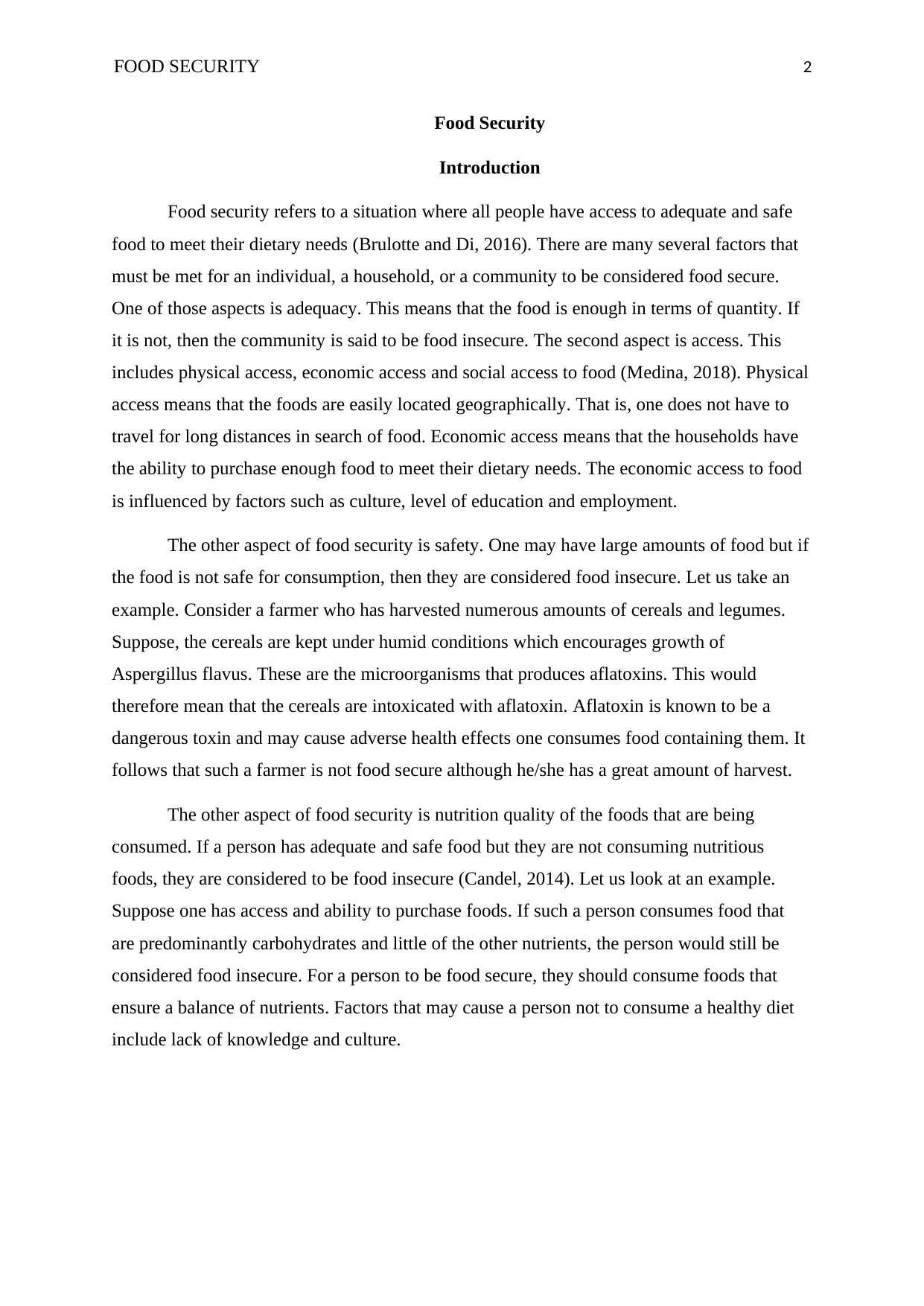
FOOD SECURITY 2
Food Security
Introduction
Food security refers to a situation where all people have access to adequate and safe
food to meet their dietary needs (Brulotte and Di, 2016). There are many several factors that
must be met for an individual, a household, or a community to be considered food secure.
One of those aspects is adequacy. This means that the food is enough in terms of quantity. If
it is not, then the community is said to be food insecure. The second aspect is access. This
includes physical access, economic access and social access to food (Medina, 2018). Physical
access means that the foods are easily located geographically. That is, one does not have to
travel for long distances in search of food. Economic access means that the households have
the ability to purchase enough food to meet their dietary needs. The economic access to food
is influenced by factors such as culture, level of education and employment.
The other aspect of food security is safety. One may have large amounts of food but if
the food is not safe for consumption, then they are considered food insecure. Let us take an
example. Consider a farmer who has harvested numerous amounts of cereals and legumes.
Suppose, the cereals are kept under humid conditions which encourages growth of
Aspergillus flavus. These are the microorganisms that produces aflatoxins. This would
therefore mean that the cereals are intoxicated with aflatoxin. Aflatoxin is known to be a
dangerous toxin and may cause adverse health effects one consumes food containing them. It
follows that such a farmer is not food secure although he/she has a great amount of harvest.
The other aspect of food security is nutrition quality of the foods that are being
consumed. If a person has adequate and safe food but they are not consuming nutritious
foods, they are considered to be food insecure (Candel, 2014). Let us look at an example.
Suppose one has access and ability to purchase foods. If such a person consumes food that
are predominantly carbohydrates and little of the other nutrients, the person would still be
considered food insecure. For a person to be food secure, they should consume foods that
ensure a balance of nutrients. Factors that may cause a person not to consume a healthy diet
include lack of knowledge and culture.
Food Security
Introduction
Food security refers to a situation where all people have access to adequate and safe
food to meet their dietary needs (Brulotte and Di, 2016). There are many several factors that
must be met for an individual, a household, or a community to be considered food secure.
One of those aspects is adequacy. This means that the food is enough in terms of quantity. If
it is not, then the community is said to be food insecure. The second aspect is access. This
includes physical access, economic access and social access to food (Medina, 2018). Physical
access means that the foods are easily located geographically. That is, one does not have to
travel for long distances in search of food. Economic access means that the households have
the ability to purchase enough food to meet their dietary needs. The economic access to food
is influenced by factors such as culture, level of education and employment.
The other aspect of food security is safety. One may have large amounts of food but if
the food is not safe for consumption, then they are considered food insecure. Let us take an
example. Consider a farmer who has harvested numerous amounts of cereals and legumes.
Suppose, the cereals are kept under humid conditions which encourages growth of
Aspergillus flavus. These are the microorganisms that produces aflatoxins. This would
therefore mean that the cereals are intoxicated with aflatoxin. Aflatoxin is known to be a
dangerous toxin and may cause adverse health effects one consumes food containing them. It
follows that such a farmer is not food secure although he/she has a great amount of harvest.
The other aspect of food security is nutrition quality of the foods that are being
consumed. If a person has adequate and safe food but they are not consuming nutritious
foods, they are considered to be food insecure (Candel, 2014). Let us look at an example.
Suppose one has access and ability to purchase foods. If such a person consumes food that
are predominantly carbohydrates and little of the other nutrients, the person would still be
considered food insecure. For a person to be food secure, they should consume foods that
ensure a balance of nutrients. Factors that may cause a person not to consume a healthy diet
include lack of knowledge and culture.
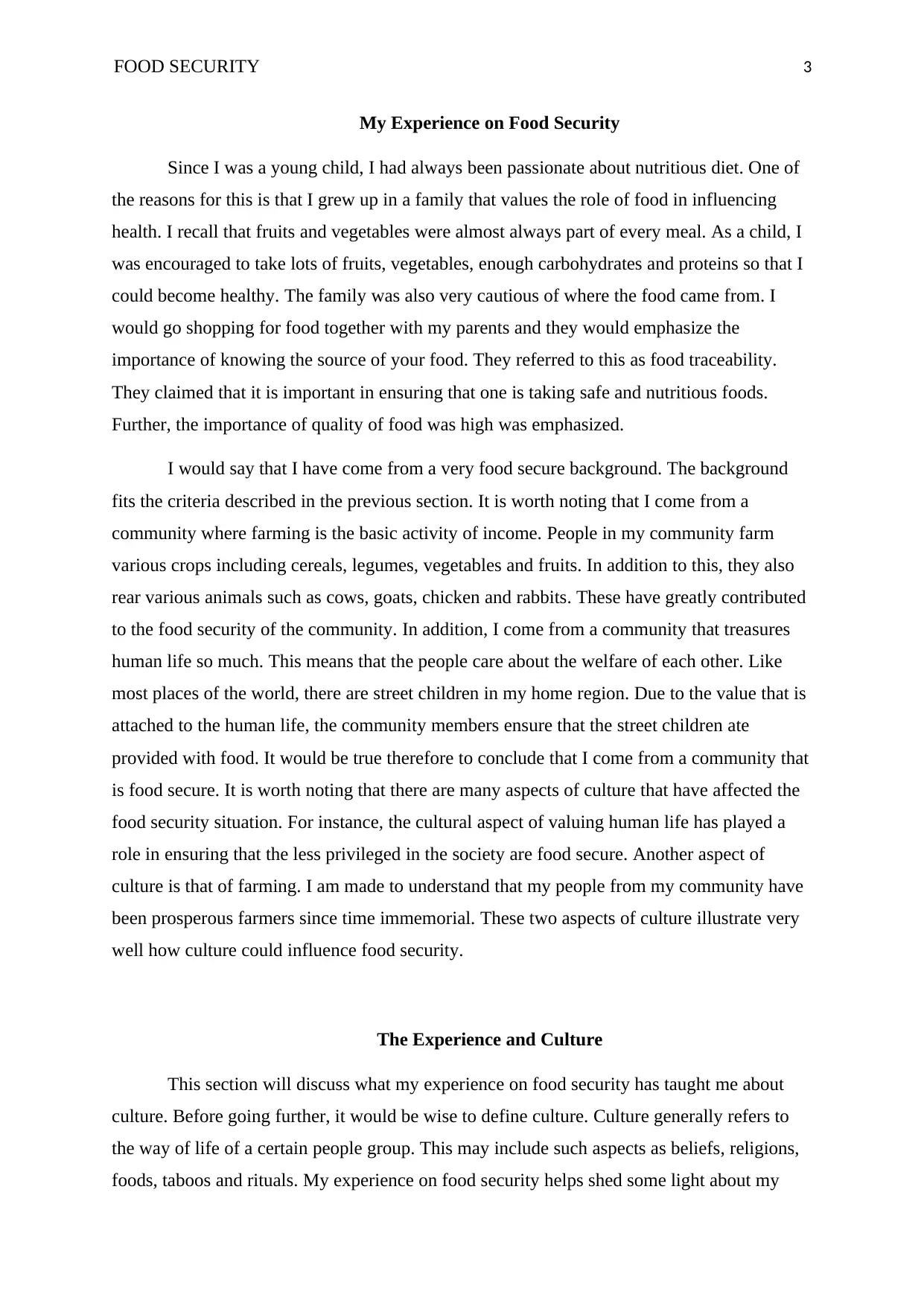
FOOD SECURITY 3
My Experience on Food Security
Since I was a young child, I had always been passionate about nutritious diet. One of
the reasons for this is that I grew up in a family that values the role of food in influencing
health. I recall that fruits and vegetables were almost always part of every meal. As a child, I
was encouraged to take lots of fruits, vegetables, enough carbohydrates and proteins so that I
could become healthy. The family was also very cautious of where the food came from. I
would go shopping for food together with my parents and they would emphasize the
importance of knowing the source of your food. They referred to this as food traceability.
They claimed that it is important in ensuring that one is taking safe and nutritious foods.
Further, the importance of quality of food was high was emphasized.
I would say that I have come from a very food secure background. The background
fits the criteria described in the previous section. It is worth noting that I come from a
community where farming is the basic activity of income. People in my community farm
various crops including cereals, legumes, vegetables and fruits. In addition to this, they also
rear various animals such as cows, goats, chicken and rabbits. These have greatly contributed
to the food security of the community. In addition, I come from a community that treasures
human life so much. This means that the people care about the welfare of each other. Like
most places of the world, there are street children in my home region. Due to the value that is
attached to the human life, the community members ensure that the street children ate
provided with food. It would be true therefore to conclude that I come from a community that
is food secure. It is worth noting that there are many aspects of culture that have affected the
food security situation. For instance, the cultural aspect of valuing human life has played a
role in ensuring that the less privileged in the society are food secure. Another aspect of
culture is that of farming. I am made to understand that my people from my community have
been prosperous farmers since time immemorial. These two aspects of culture illustrate very
well how culture could influence food security.
The Experience and Culture
This section will discuss what my experience on food security has taught me about
culture. Before going further, it would be wise to define culture. Culture generally refers to
the way of life of a certain people group. This may include such aspects as beliefs, religions,
foods, taboos and rituals. My experience on food security helps shed some light about my
My Experience on Food Security
Since I was a young child, I had always been passionate about nutritious diet. One of
the reasons for this is that I grew up in a family that values the role of food in influencing
health. I recall that fruits and vegetables were almost always part of every meal. As a child, I
was encouraged to take lots of fruits, vegetables, enough carbohydrates and proteins so that I
could become healthy. The family was also very cautious of where the food came from. I
would go shopping for food together with my parents and they would emphasize the
importance of knowing the source of your food. They referred to this as food traceability.
They claimed that it is important in ensuring that one is taking safe and nutritious foods.
Further, the importance of quality of food was high was emphasized.
I would say that I have come from a very food secure background. The background
fits the criteria described in the previous section. It is worth noting that I come from a
community where farming is the basic activity of income. People in my community farm
various crops including cereals, legumes, vegetables and fruits. In addition to this, they also
rear various animals such as cows, goats, chicken and rabbits. These have greatly contributed
to the food security of the community. In addition, I come from a community that treasures
human life so much. This means that the people care about the welfare of each other. Like
most places of the world, there are street children in my home region. Due to the value that is
attached to the human life, the community members ensure that the street children ate
provided with food. It would be true therefore to conclude that I come from a community that
is food secure. It is worth noting that there are many aspects of culture that have affected the
food security situation. For instance, the cultural aspect of valuing human life has played a
role in ensuring that the less privileged in the society are food secure. Another aspect of
culture is that of farming. I am made to understand that my people from my community have
been prosperous farmers since time immemorial. These two aspects of culture illustrate very
well how culture could influence food security.
The Experience and Culture
This section will discuss what my experience on food security has taught me about
culture. Before going further, it would be wise to define culture. Culture generally refers to
the way of life of a certain people group. This may include such aspects as beliefs, religions,
foods, taboos and rituals. My experience on food security helps shed some light about my
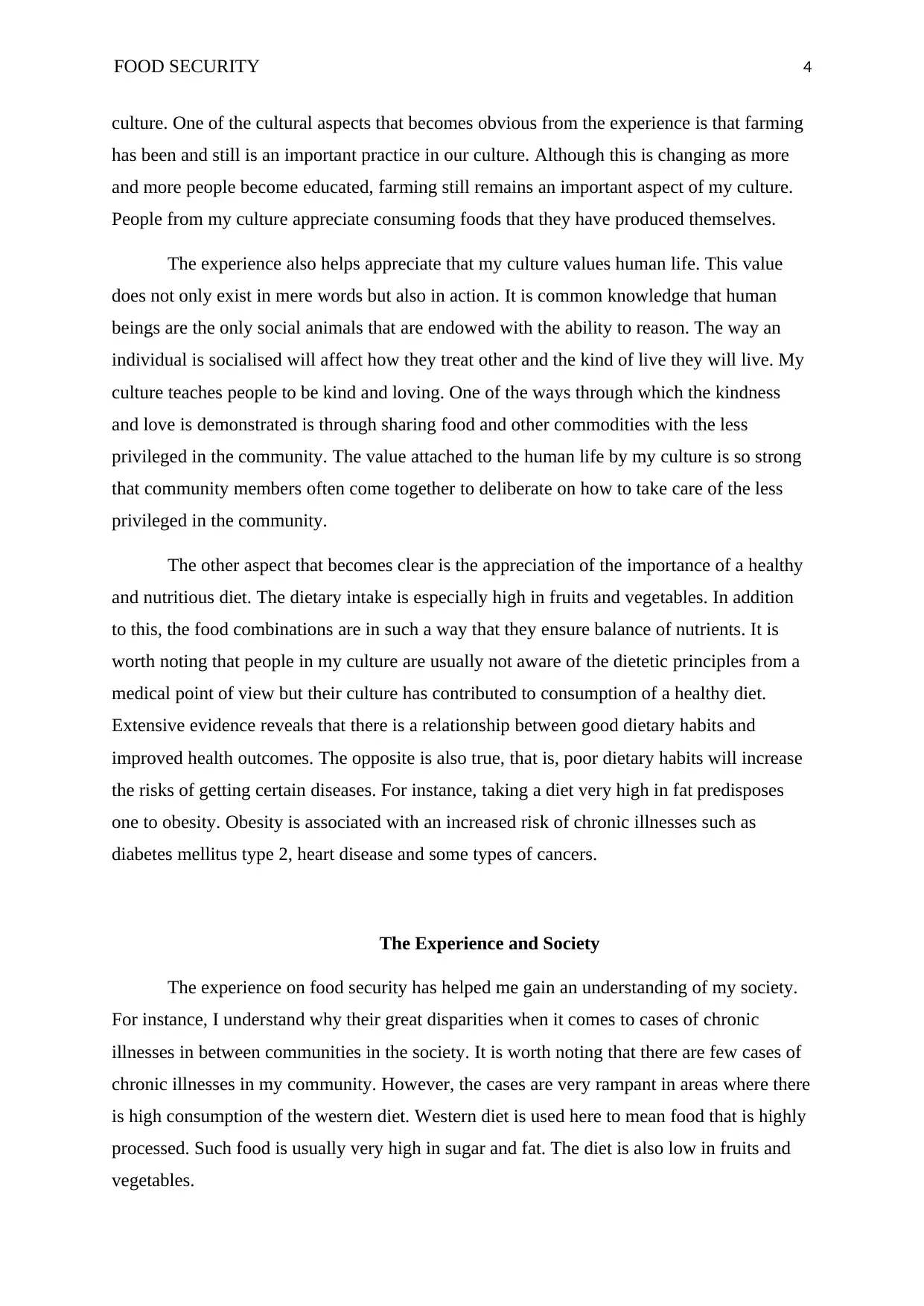
FOOD SECURITY 4
culture. One of the cultural aspects that becomes obvious from the experience is that farming
has been and still is an important practice in our culture. Although this is changing as more
and more people become educated, farming still remains an important aspect of my culture.
People from my culture appreciate consuming foods that they have produced themselves.
The experience also helps appreciate that my culture values human life. This value
does not only exist in mere words but also in action. It is common knowledge that human
beings are the only social animals that are endowed with the ability to reason. The way an
individual is socialised will affect how they treat other and the kind of live they will live. My
culture teaches people to be kind and loving. One of the ways through which the kindness
and love is demonstrated is through sharing food and other commodities with the less
privileged in the community. The value attached to the human life by my culture is so strong
that community members often come together to deliberate on how to take care of the less
privileged in the community.
The other aspect that becomes clear is the appreciation of the importance of a healthy
and nutritious diet. The dietary intake is especially high in fruits and vegetables. In addition
to this, the food combinations are in such a way that they ensure balance of nutrients. It is
worth noting that people in my culture are usually not aware of the dietetic principles from a
medical point of view but their culture has contributed to consumption of a healthy diet.
Extensive evidence reveals that there is a relationship between good dietary habits and
improved health outcomes. The opposite is also true, that is, poor dietary habits will increase
the risks of getting certain diseases. For instance, taking a diet very high in fat predisposes
one to obesity. Obesity is associated with an increased risk of chronic illnesses such as
diabetes mellitus type 2, heart disease and some types of cancers.
The Experience and Society
The experience on food security has helped me gain an understanding of my society.
For instance, I understand why their great disparities when it comes to cases of chronic
illnesses in between communities in the society. It is worth noting that there are few cases of
chronic illnesses in my community. However, the cases are very rampant in areas where there
is high consumption of the western diet. Western diet is used here to mean food that is highly
processed. Such food is usually very high in sugar and fat. The diet is also low in fruits and
vegetables.
culture. One of the cultural aspects that becomes obvious from the experience is that farming
has been and still is an important practice in our culture. Although this is changing as more
and more people become educated, farming still remains an important aspect of my culture.
People from my culture appreciate consuming foods that they have produced themselves.
The experience also helps appreciate that my culture values human life. This value
does not only exist in mere words but also in action. It is common knowledge that human
beings are the only social animals that are endowed with the ability to reason. The way an
individual is socialised will affect how they treat other and the kind of live they will live. My
culture teaches people to be kind and loving. One of the ways through which the kindness
and love is demonstrated is through sharing food and other commodities with the less
privileged in the community. The value attached to the human life by my culture is so strong
that community members often come together to deliberate on how to take care of the less
privileged in the community.
The other aspect that becomes clear is the appreciation of the importance of a healthy
and nutritious diet. The dietary intake is especially high in fruits and vegetables. In addition
to this, the food combinations are in such a way that they ensure balance of nutrients. It is
worth noting that people in my culture are usually not aware of the dietetic principles from a
medical point of view but their culture has contributed to consumption of a healthy diet.
Extensive evidence reveals that there is a relationship between good dietary habits and
improved health outcomes. The opposite is also true, that is, poor dietary habits will increase
the risks of getting certain diseases. For instance, taking a diet very high in fat predisposes
one to obesity. Obesity is associated with an increased risk of chronic illnesses such as
diabetes mellitus type 2, heart disease and some types of cancers.
The Experience and Society
The experience on food security has helped me gain an understanding of my society.
For instance, I understand why their great disparities when it comes to cases of chronic
illnesses in between communities in the society. It is worth noting that there are few cases of
chronic illnesses in my community. However, the cases are very rampant in areas where there
is high consumption of the western diet. Western diet is used here to mean food that is highly
processed. Such food is usually very high in sugar and fat. The diet is also low in fruits and
vegetables.
Secure Best Marks with AI Grader
Need help grading? Try our AI Grader for instant feedback on your assignments.
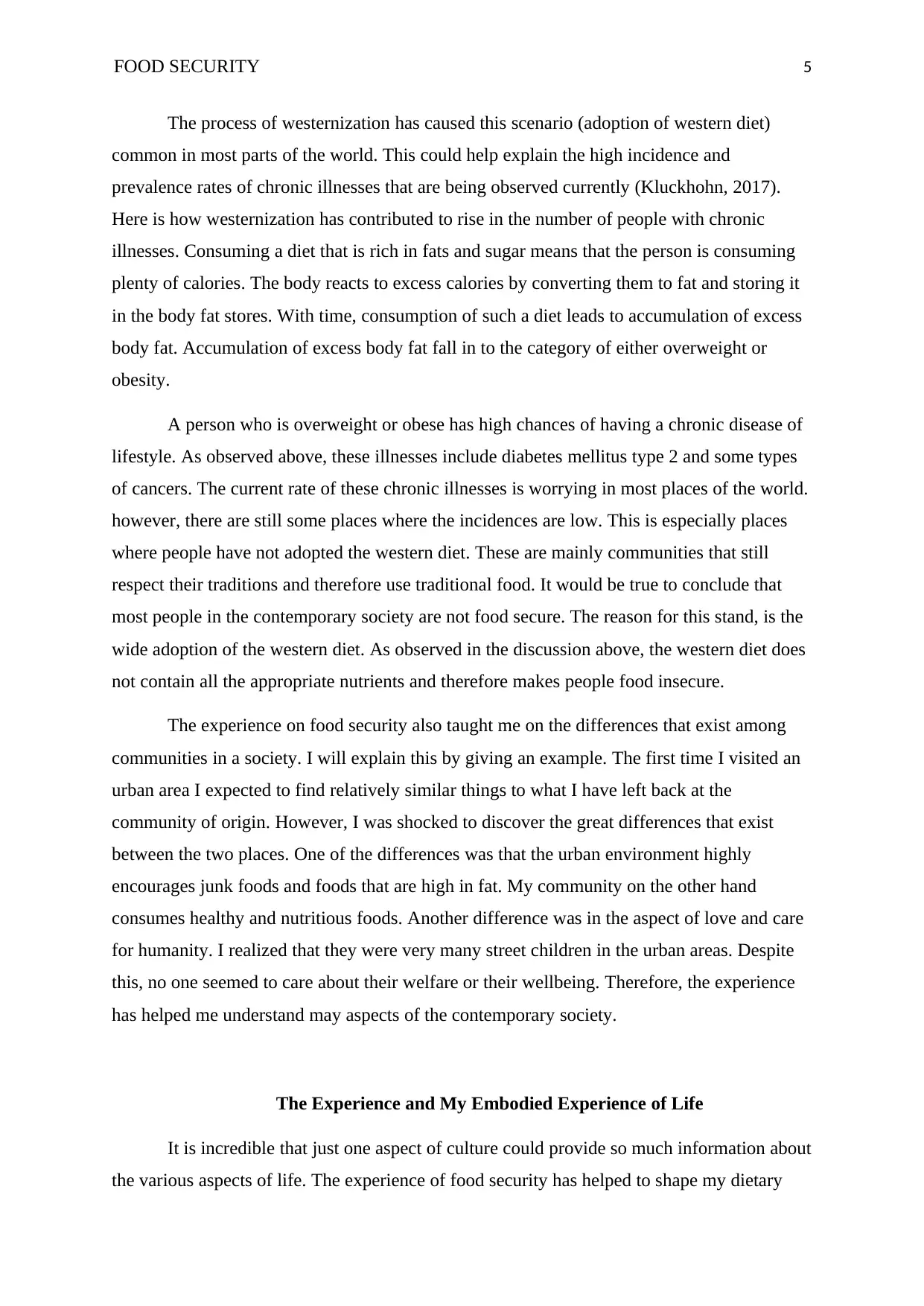
FOOD SECURITY 5
The process of westernization has caused this scenario (adoption of western diet)
common in most parts of the world. This could help explain the high incidence and
prevalence rates of chronic illnesses that are being observed currently (Kluckhohn, 2017).
Here is how westernization has contributed to rise in the number of people with chronic
illnesses. Consuming a diet that is rich in fats and sugar means that the person is consuming
plenty of calories. The body reacts to excess calories by converting them to fat and storing it
in the body fat stores. With time, consumption of such a diet leads to accumulation of excess
body fat. Accumulation of excess body fat fall in to the category of either overweight or
obesity.
A person who is overweight or obese has high chances of having a chronic disease of
lifestyle. As observed above, these illnesses include diabetes mellitus type 2 and some types
of cancers. The current rate of these chronic illnesses is worrying in most places of the world.
however, there are still some places where the incidences are low. This is especially places
where people have not adopted the western diet. These are mainly communities that still
respect their traditions and therefore use traditional food. It would be true to conclude that
most people in the contemporary society are not food secure. The reason for this stand, is the
wide adoption of the western diet. As observed in the discussion above, the western diet does
not contain all the appropriate nutrients and therefore makes people food insecure.
The experience on food security also taught me on the differences that exist among
communities in a society. I will explain this by giving an example. The first time I visited an
urban area I expected to find relatively similar things to what I have left back at the
community of origin. However, I was shocked to discover the great differences that exist
between the two places. One of the differences was that the urban environment highly
encourages junk foods and foods that are high in fat. My community on the other hand
consumes healthy and nutritious foods. Another difference was in the aspect of love and care
for humanity. I realized that they were very many street children in the urban areas. Despite
this, no one seemed to care about their welfare or their wellbeing. Therefore, the experience
has helped me understand may aspects of the contemporary society.
The Experience and My Embodied Experience of Life
It is incredible that just one aspect of culture could provide so much information about
the various aspects of life. The experience of food security has helped to shape my dietary
The process of westernization has caused this scenario (adoption of western diet)
common in most parts of the world. This could help explain the high incidence and
prevalence rates of chronic illnesses that are being observed currently (Kluckhohn, 2017).
Here is how westernization has contributed to rise in the number of people with chronic
illnesses. Consuming a diet that is rich in fats and sugar means that the person is consuming
plenty of calories. The body reacts to excess calories by converting them to fat and storing it
in the body fat stores. With time, consumption of such a diet leads to accumulation of excess
body fat. Accumulation of excess body fat fall in to the category of either overweight or
obesity.
A person who is overweight or obese has high chances of having a chronic disease of
lifestyle. As observed above, these illnesses include diabetes mellitus type 2 and some types
of cancers. The current rate of these chronic illnesses is worrying in most places of the world.
however, there are still some places where the incidences are low. This is especially places
where people have not adopted the western diet. These are mainly communities that still
respect their traditions and therefore use traditional food. It would be true to conclude that
most people in the contemporary society are not food secure. The reason for this stand, is the
wide adoption of the western diet. As observed in the discussion above, the western diet does
not contain all the appropriate nutrients and therefore makes people food insecure.
The experience on food security also taught me on the differences that exist among
communities in a society. I will explain this by giving an example. The first time I visited an
urban area I expected to find relatively similar things to what I have left back at the
community of origin. However, I was shocked to discover the great differences that exist
between the two places. One of the differences was that the urban environment highly
encourages junk foods and foods that are high in fat. My community on the other hand
consumes healthy and nutritious foods. Another difference was in the aspect of love and care
for humanity. I realized that they were very many street children in the urban areas. Despite
this, no one seemed to care about their welfare or their wellbeing. Therefore, the experience
has helped me understand may aspects of the contemporary society.
The Experience and My Embodied Experience of Life
It is incredible that just one aspect of culture could provide so much information about
the various aspects of life. The experience of food security has helped to shape my dietary
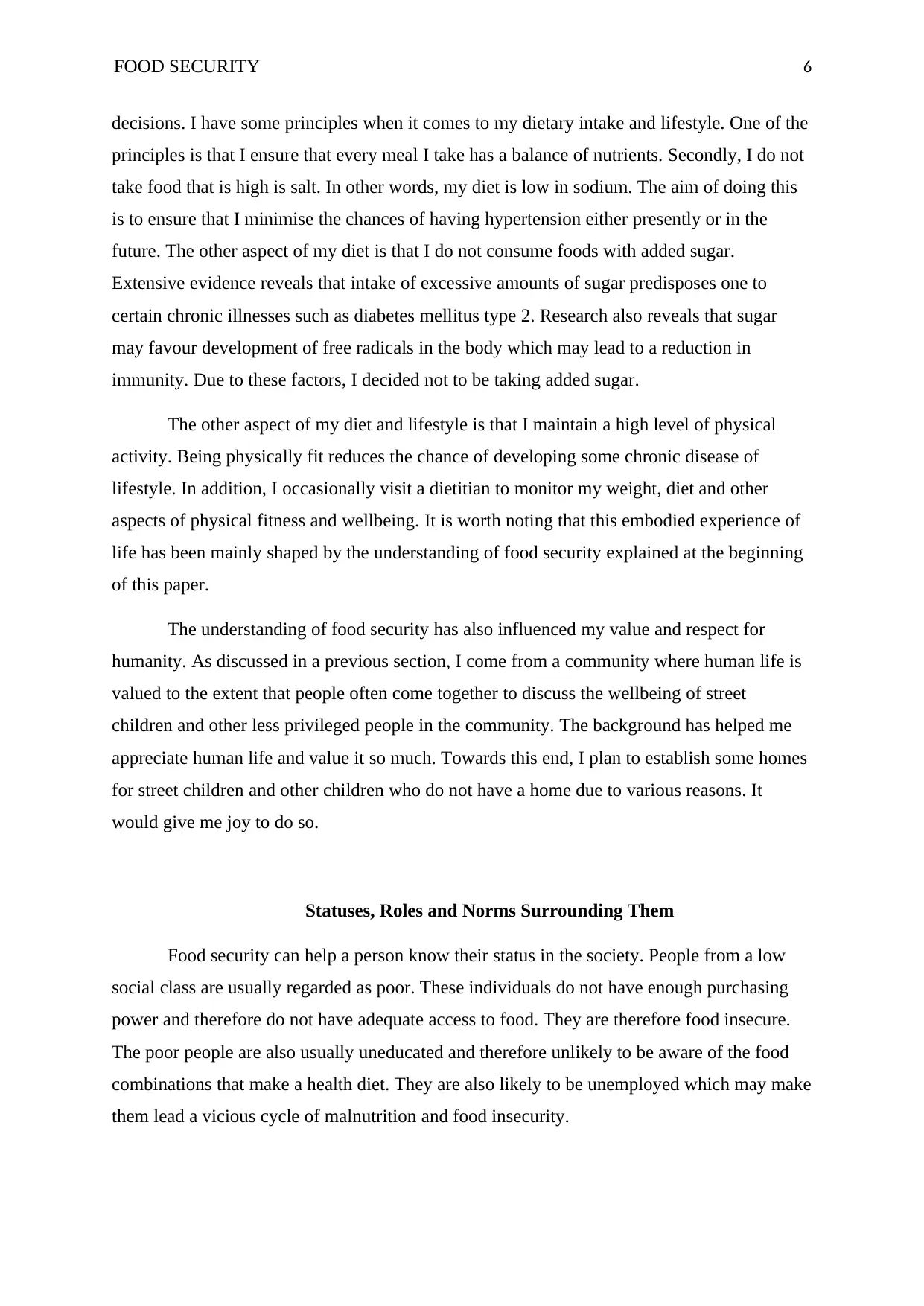
FOOD SECURITY 6
decisions. I have some principles when it comes to my dietary intake and lifestyle. One of the
principles is that I ensure that every meal I take has a balance of nutrients. Secondly, I do not
take food that is high is salt. In other words, my diet is low in sodium. The aim of doing this
is to ensure that I minimise the chances of having hypertension either presently or in the
future. The other aspect of my diet is that I do not consume foods with added sugar.
Extensive evidence reveals that intake of excessive amounts of sugar predisposes one to
certain chronic illnesses such as diabetes mellitus type 2. Research also reveals that sugar
may favour development of free radicals in the body which may lead to a reduction in
immunity. Due to these factors, I decided not to be taking added sugar.
The other aspect of my diet and lifestyle is that I maintain a high level of physical
activity. Being physically fit reduces the chance of developing some chronic disease of
lifestyle. In addition, I occasionally visit a dietitian to monitor my weight, diet and other
aspects of physical fitness and wellbeing. It is worth noting that this embodied experience of
life has been mainly shaped by the understanding of food security explained at the beginning
of this paper.
The understanding of food security has also influenced my value and respect for
humanity. As discussed in a previous section, I come from a community where human life is
valued to the extent that people often come together to discuss the wellbeing of street
children and other less privileged people in the community. The background has helped me
appreciate human life and value it so much. Towards this end, I plan to establish some homes
for street children and other children who do not have a home due to various reasons. It
would give me joy to do so.
Statuses, Roles and Norms Surrounding Them
Food security can help a person know their status in the society. People from a low
social class are usually regarded as poor. These individuals do not have enough purchasing
power and therefore do not have adequate access to food. They are therefore food insecure.
The poor people are also usually uneducated and therefore unlikely to be aware of the food
combinations that make a health diet. They are also likely to be unemployed which may make
them lead a vicious cycle of malnutrition and food insecurity.
decisions. I have some principles when it comes to my dietary intake and lifestyle. One of the
principles is that I ensure that every meal I take has a balance of nutrients. Secondly, I do not
take food that is high is salt. In other words, my diet is low in sodium. The aim of doing this
is to ensure that I minimise the chances of having hypertension either presently or in the
future. The other aspect of my diet is that I do not consume foods with added sugar.
Extensive evidence reveals that intake of excessive amounts of sugar predisposes one to
certain chronic illnesses such as diabetes mellitus type 2. Research also reveals that sugar
may favour development of free radicals in the body which may lead to a reduction in
immunity. Due to these factors, I decided not to be taking added sugar.
The other aspect of my diet and lifestyle is that I maintain a high level of physical
activity. Being physically fit reduces the chance of developing some chronic disease of
lifestyle. In addition, I occasionally visit a dietitian to monitor my weight, diet and other
aspects of physical fitness and wellbeing. It is worth noting that this embodied experience of
life has been mainly shaped by the understanding of food security explained at the beginning
of this paper.
The understanding of food security has also influenced my value and respect for
humanity. As discussed in a previous section, I come from a community where human life is
valued to the extent that people often come together to discuss the wellbeing of street
children and other less privileged people in the community. The background has helped me
appreciate human life and value it so much. Towards this end, I plan to establish some homes
for street children and other children who do not have a home due to various reasons. It
would give me joy to do so.
Statuses, Roles and Norms Surrounding Them
Food security can help a person know their status in the society. People from a low
social class are usually regarded as poor. These individuals do not have enough purchasing
power and therefore do not have adequate access to food. They are therefore food insecure.
The poor people are also usually uneducated and therefore unlikely to be aware of the food
combinations that make a health diet. They are also likely to be unemployed which may make
them lead a vicious cycle of malnutrition and food insecurity.
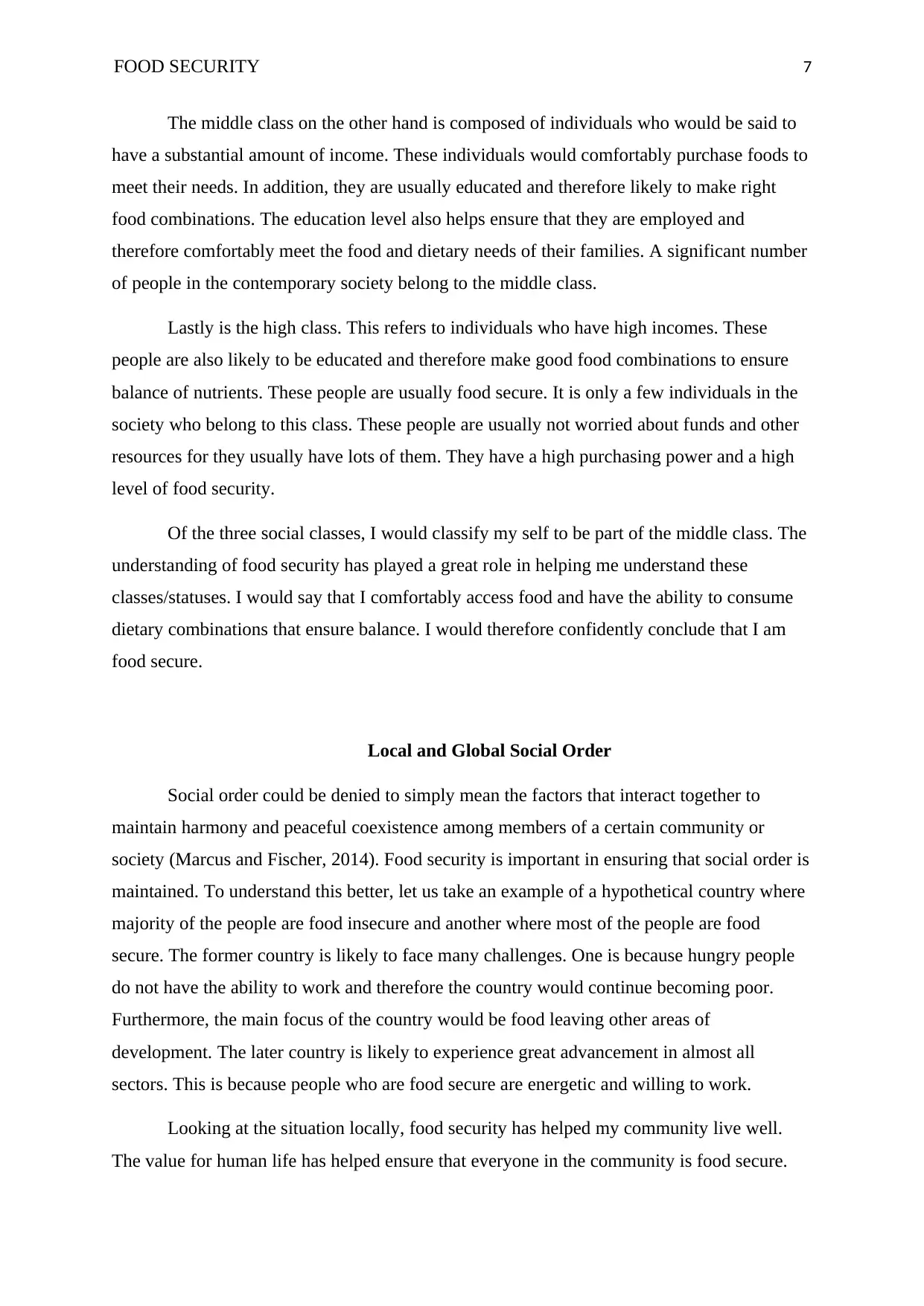
FOOD SECURITY 7
The middle class on the other hand is composed of individuals who would be said to
have a substantial amount of income. These individuals would comfortably purchase foods to
meet their needs. In addition, they are usually educated and therefore likely to make right
food combinations. The education level also helps ensure that they are employed and
therefore comfortably meet the food and dietary needs of their families. A significant number
of people in the contemporary society belong to the middle class.
Lastly is the high class. This refers to individuals who have high incomes. These
people are also likely to be educated and therefore make good food combinations to ensure
balance of nutrients. These people are usually food secure. It is only a few individuals in the
society who belong to this class. These people are usually not worried about funds and other
resources for they usually have lots of them. They have a high purchasing power and a high
level of food security.
Of the three social classes, I would classify my self to be part of the middle class. The
understanding of food security has played a great role in helping me understand these
classes/statuses. I would say that I comfortably access food and have the ability to consume
dietary combinations that ensure balance. I would therefore confidently conclude that I am
food secure.
Local and Global Social Order
Social order could be denied to simply mean the factors that interact together to
maintain harmony and peaceful coexistence among members of a certain community or
society (Marcus and Fischer, 2014). Food security is important in ensuring that social order is
maintained. To understand this better, let us take an example of a hypothetical country where
majority of the people are food insecure and another where most of the people are food
secure. The former country is likely to face many challenges. One is because hungry people
do not have the ability to work and therefore the country would continue becoming poor.
Furthermore, the main focus of the country would be food leaving other areas of
development. The later country is likely to experience great advancement in almost all
sectors. This is because people who are food secure are energetic and willing to work.
Looking at the situation locally, food security has helped my community live well.
The value for human life has helped ensure that everyone in the community is food secure.
The middle class on the other hand is composed of individuals who would be said to
have a substantial amount of income. These individuals would comfortably purchase foods to
meet their needs. In addition, they are usually educated and therefore likely to make right
food combinations. The education level also helps ensure that they are employed and
therefore comfortably meet the food and dietary needs of their families. A significant number
of people in the contemporary society belong to the middle class.
Lastly is the high class. This refers to individuals who have high incomes. These
people are also likely to be educated and therefore make good food combinations to ensure
balance of nutrients. These people are usually food secure. It is only a few individuals in the
society who belong to this class. These people are usually not worried about funds and other
resources for they usually have lots of them. They have a high purchasing power and a high
level of food security.
Of the three social classes, I would classify my self to be part of the middle class. The
understanding of food security has played a great role in helping me understand these
classes/statuses. I would say that I comfortably access food and have the ability to consume
dietary combinations that ensure balance. I would therefore confidently conclude that I am
food secure.
Local and Global Social Order
Social order could be denied to simply mean the factors that interact together to
maintain harmony and peaceful coexistence among members of a certain community or
society (Marcus and Fischer, 2014). Food security is important in ensuring that social order is
maintained. To understand this better, let us take an example of a hypothetical country where
majority of the people are food insecure and another where most of the people are food
secure. The former country is likely to face many challenges. One is because hungry people
do not have the ability to work and therefore the country would continue becoming poor.
Furthermore, the main focus of the country would be food leaving other areas of
development. The later country is likely to experience great advancement in almost all
sectors. This is because people who are food secure are energetic and willing to work.
Looking at the situation locally, food security has helped my community live well.
The value for human life has helped ensure that everyone in the community is food secure.
Paraphrase This Document
Need a fresh take? Get an instant paraphrase of this document with our AI Paraphraser
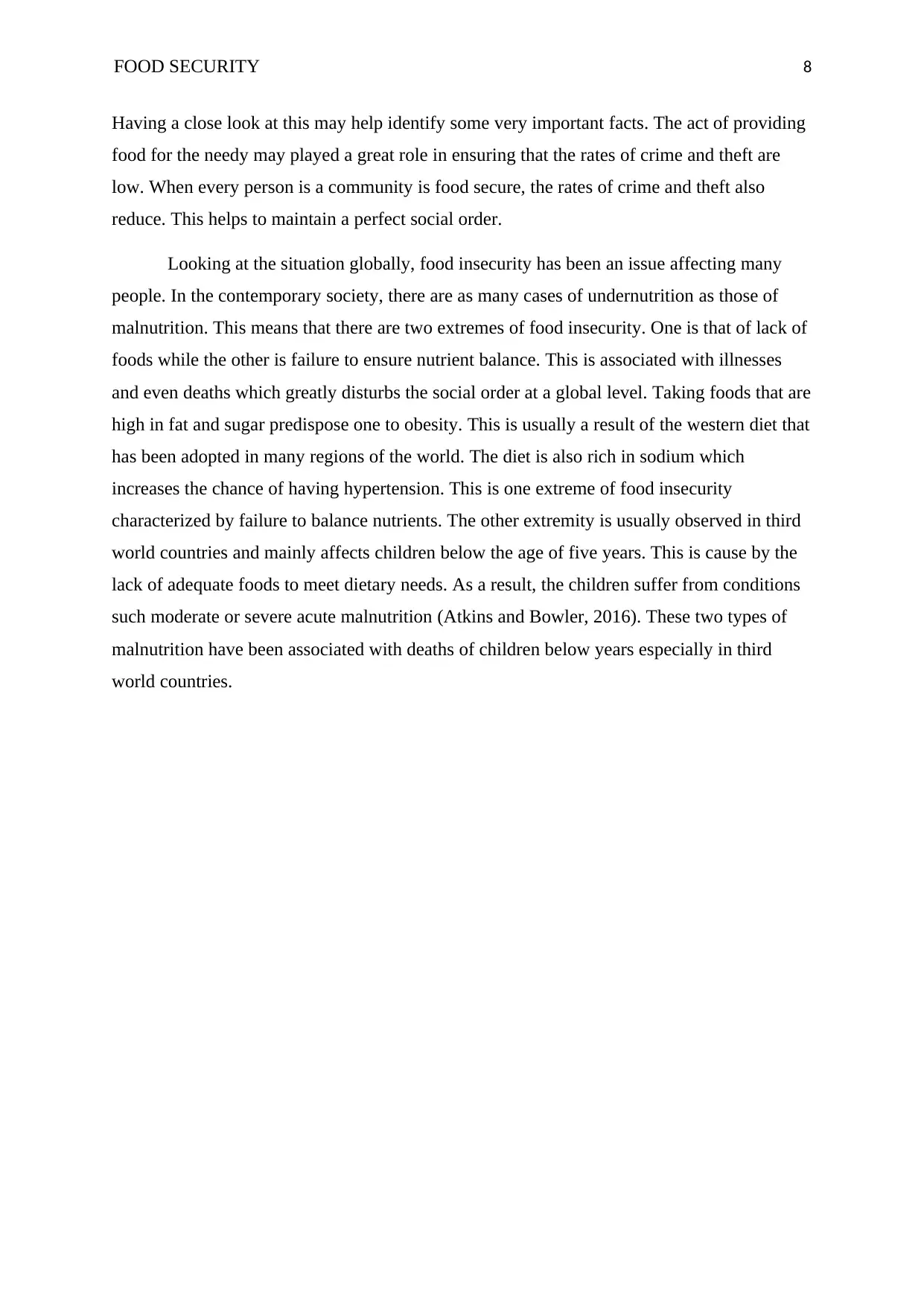
FOOD SECURITY 8
Having a close look at this may help identify some very important facts. The act of providing
food for the needy may played a great role in ensuring that the rates of crime and theft are
low. When every person is a community is food secure, the rates of crime and theft also
reduce. This helps to maintain a perfect social order.
Looking at the situation globally, food insecurity has been an issue affecting many
people. In the contemporary society, there are as many cases of undernutrition as those of
malnutrition. This means that there are two extremes of food insecurity. One is that of lack of
foods while the other is failure to ensure nutrient balance. This is associated with illnesses
and even deaths which greatly disturbs the social order at a global level. Taking foods that are
high in fat and sugar predispose one to obesity. This is usually a result of the western diet that
has been adopted in many regions of the world. The diet is also rich in sodium which
increases the chance of having hypertension. This is one extreme of food insecurity
characterized by failure to balance nutrients. The other extremity is usually observed in third
world countries and mainly affects children below the age of five years. This is cause by the
lack of adequate foods to meet dietary needs. As a result, the children suffer from conditions
such moderate or severe acute malnutrition (Atkins and Bowler, 2016). These two types of
malnutrition have been associated with deaths of children below years especially in third
world countries.
Having a close look at this may help identify some very important facts. The act of providing
food for the needy may played a great role in ensuring that the rates of crime and theft are
low. When every person is a community is food secure, the rates of crime and theft also
reduce. This helps to maintain a perfect social order.
Looking at the situation globally, food insecurity has been an issue affecting many
people. In the contemporary society, there are as many cases of undernutrition as those of
malnutrition. This means that there are two extremes of food insecurity. One is that of lack of
foods while the other is failure to ensure nutrient balance. This is associated with illnesses
and even deaths which greatly disturbs the social order at a global level. Taking foods that are
high in fat and sugar predispose one to obesity. This is usually a result of the western diet that
has been adopted in many regions of the world. The diet is also rich in sodium which
increases the chance of having hypertension. This is one extreme of food insecurity
characterized by failure to balance nutrients. The other extremity is usually observed in third
world countries and mainly affects children below the age of five years. This is cause by the
lack of adequate foods to meet dietary needs. As a result, the children suffer from conditions
such moderate or severe acute malnutrition (Atkins and Bowler, 2016). These two types of
malnutrition have been associated with deaths of children below years especially in third
world countries.
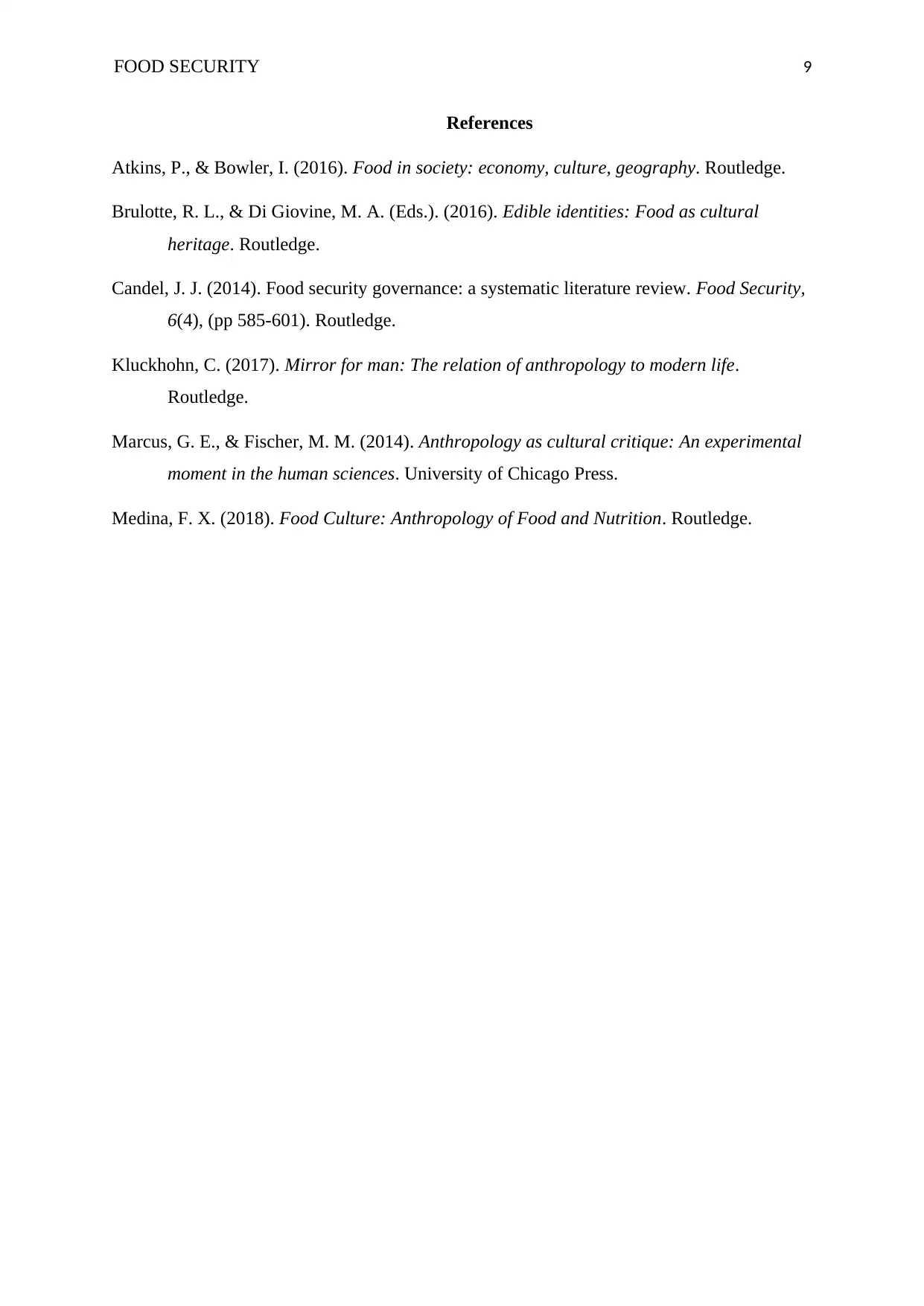
FOOD SECURITY 9
References
Atkins, P., & Bowler, I. (2016). Food in society: economy, culture, geography. Routledge.
Brulotte, R. L., & Di Giovine, M. A. (Eds.). (2016). Edible identities: Food as cultural
heritage. Routledge.
Candel, J. J. (2014). Food security governance: a systematic literature review. Food Security,
6(4), (pp 585-601). Routledge.
Kluckhohn, C. (2017). Mirror for man: The relation of anthropology to modern life.
Routledge.
Marcus, G. E., & Fischer, M. M. (2014). Anthropology as cultural critique: An experimental
moment in the human sciences. University of Chicago Press.
Medina, F. X. (2018). Food Culture: Anthropology of Food and Nutrition. Routledge.
References
Atkins, P., & Bowler, I. (2016). Food in society: economy, culture, geography. Routledge.
Brulotte, R. L., & Di Giovine, M. A. (Eds.). (2016). Edible identities: Food as cultural
heritage. Routledge.
Candel, J. J. (2014). Food security governance: a systematic literature review. Food Security,
6(4), (pp 585-601). Routledge.
Kluckhohn, C. (2017). Mirror for man: The relation of anthropology to modern life.
Routledge.
Marcus, G. E., & Fischer, M. M. (2014). Anthropology as cultural critique: An experimental
moment in the human sciences. University of Chicago Press.
Medina, F. X. (2018). Food Culture: Anthropology of Food and Nutrition. Routledge.
1 out of 9
Related Documents
Your All-in-One AI-Powered Toolkit for Academic Success.
+13062052269
info@desklib.com
Available 24*7 on WhatsApp / Email
![[object Object]](/_next/static/media/star-bottom.7253800d.svg)
Unlock your academic potential
© 2024 | Zucol Services PVT LTD | All rights reserved.





